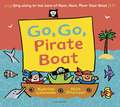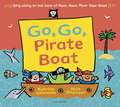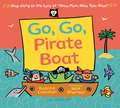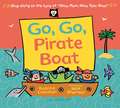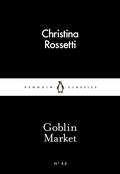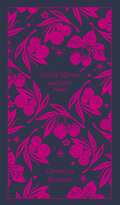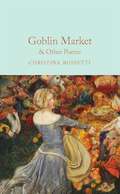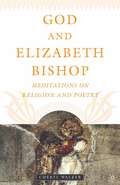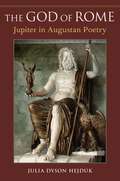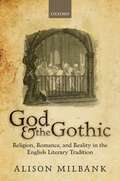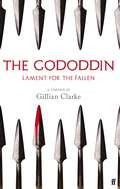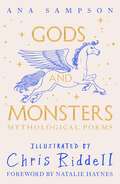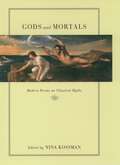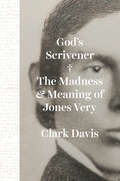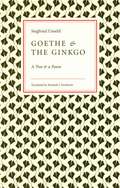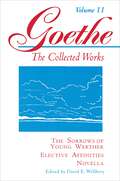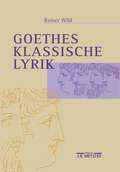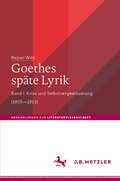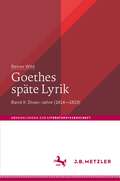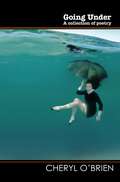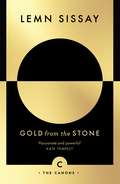- Table View
- List View
Go, Go, Pirate Boat
by Katrina CharmanJoin two seafaring pirates and their captain on a nautical adventure to find a treasure chest. Add to that a text that is read aloud to the tune of 'Row, Row, Row Your Boat' and you have a book that will be enjoyed time and time again! Go, go, pirate boat,Across the salty sea,Raise the anchor, hoist the sail,It's a pirate's life for me.Little pirate fans will have endless fun singing along to the tune of a favourite nursery rhyme and doing the pirate actions in this fun ocean adventure. With bold, colourful illustrations by the instantly recognisable Nick Sharratt and text by talented newcomer Katrina Charman.
Go, Go, Pirate Boat
by Katrina CharmanJoin two seafaring pirates and their captain on a nautical adventure to find a treasure chest. Add to that a text that is read aloud to the tune of 'Row, Row, Row Your Boat' and you have a book that will be enjoyed time and time again! Go, go, pirate boat,Across the salty sea,Raise the anchor, hoist the sail,It's a pirate's life for me.Little pirate fans will have endless fun singing along to the tune of a favourite nursery rhyme and doing the pirate actions in this fun ocean adventure. With bold, colourful illustrations by the instantly recognisable Nick Sharratt and text by talented newcomer Katrina Charman. This eBook comes with glorious musical audio accompaniment by CBeebies star Justin Fletcher, so that everyone can sing along!
Go, Go, Pirate Boat
by Katrina CharmanAn Amazon Best Book of the Year!Little pirates will have endless fun with this vibrant board book that's set to the tune of Row, Row, Row Your Boat!Go, go, pirate boat,Across the salty sea,Raise the anchor, hoist the sail,It's a pirate's life for me.Join two seafaring pirates and their captain on a nautical adventure to find a treasure chest. Add to that a text that is read aloud to the tune of Row, Row, Row Your Boat and you have a book that will be enjoyed time and time again! Acclaim for Car, Car, Truck, JeepAn Amazon Best Book of the Year
Go, Go, Pirate Boat
by Katrina CharmanLittle pirates will have endless fun with this vibrant board book that's set to the tune of Row, Row, Row Your Boat!Go, go, pirate boat,Across the salty sea,Raise the anchor, hoist the sail,It's a pirate's life for me.Join two seafaring pirates and their captain on a nautical adventure to find a treasure chest. Add to that a text that is read aloud to the tune of Row, Row, Row Your Boat and you have a book that will be enjoyed time and time again! Acclaim for Car, Car, Truck, JeepAn Amazon Best Book of the Year
Goblin Market: The Prince's Progress, And Other Poems (Penguin Little Black Classics #No. 53)
by Christina Rossetti'She kissed and kissed her with a hungry mouth'A selection of Rossetti's most famous poems, from the hallucinatory 'Goblin Market' to 'In the bleak mid-winter' Introducing Little Black Classics: 80 books for Penguin's 80th birthday. Little Black Classics celebrate the huge range and diversity of Penguin Classics, with books from around the world and across many centuries. They take us from a balloon ride over Victorian London to a garden of blossom in Japan, from Tierra del Fuego to 16th century California and the Russian steppe. Here are stories lyrical and savage; poems epic and intimate; essays satirical and inspirational; and ideas that have shaped the lives of millions.Christina Rossetti (1830-1894). Rossetti's The Complete Poems is available in Penguin Classics.
Goblin Market and Other Poems (Penguin Clothbound Poetry)
by Christina RossettiA collectible new Penguin Classics series: stunning, clothbound editions of ten favourite poets, which present each poet's most famous book of verse as it was originally published. Designed by the acclaimed Coralie Bickford-Smith and beautifully set, these slim, A format volumes are the ultimate gift editions for poetry lovers. Goblin Market and Other Poems was Christina Rossetti's first full volume of poetry, published in 1862. The collection received widespread critical praise and established Rossetti as the foremost female poet of her time. Tennyson, Hopkins and Swinburne all admired her work. The title poem 'Goblin Market' is arguably her most famous, a fairy tale entwining themes of sisterhood, temptation and sexuality. This collection also includes 'Up-hill', an allegorical dialogue on life and death and 'Maude Clare', a ballad of a woman scorned.
Goblin Market & Other Poems (Macmillan Collector's Library #335)
by Christina RossettiWith a preface by Elizabeth Macneal and original illustrations by Laurence Housman.Two sisters, Laura and Lizzie, are enticed by the smells, sounds and sights of the goblin market, tempted by the ripe figs, plump cherries and fragrant berries. Whilst Lizzie resists, Laura is slowly destroyed by her insatiable longing for the goblin’s forbidden fruit.Complete & Unabridged. Part of the Macmillan Collector’s Library; a series of stunning, clothbound, pocket-sized classics with gold foiled edges and ribbon markers. These beautiful books make perfect gifts or a treat for any book lover. Here is Christina Rossetti’s first critically acclaimed collection of poetry. Published in 1862, as well as ‘Goblin Market’ it contains some of her most treasured work, such as ‘A Birthday’, ‘An Apple Gathering’ and ‘Remember’. It launched her career as the foremost female poet of her time and, more than a century later, modern readers are still seduced by its symbolism and sensual language.
God and Elizabeth Bishop: Meditations on Religion and Poetry
by C. WalkerIn God and Elizabeth Bishop Cheryl Walker takes the bold step of looking at the work of Elizabeth Bishop as though it might have something fresh to say about religion and poetry. Going wholly against the tide of recent academic practice, especially as applied to Bishop, she delights in presenting herself as an engaged Christian who nevertheless believes that a skeptical modern poet might feed our spiritual hungers. This is a book that reminds us of the rich tradition of religious poetry written in English, at the same time taking delicious detours into realms of humour, social responsibility, and mysticism.
The God of Rome: Jupiter in Augustan Poetry
by Julia HejdukInspiring reverence and blasphemy, combining paternal benignity with sexual violence, transcendent universality with tribal chauvinism, Jupiter represents both the best and the worst of ancient religion. Though often assimilated to Zeus, Jupiter differs from his Greek counterpart as much as Rome differs from Greece: "the god of Rome" conveys both Jupiter's sovereignty over Rome and his symbolic encapsulation of what Rome represents. Understanding this dizzyingly complex figure is crucial not only to the study of Roman religion, but also to the study of ancient Rome more generally. The God of Rome examines Jupiter in Latin poetry's most formative and fruitful period, the reign of the emperor Augustus. As Roman society was transformed from a republic or oligarchy to a de facto monarchy, Jupiter came to play a unique role as the celestial counterpart of the first earthly princeps. While studies of Augustan poetry may glance at Jupiter as an Augustus figure, or Augustus as a Jupiter figure, they rarely explore the poets' portrayal of the god as a character in his own right. This book fills that gap, exploring the god's manifestations in the five major Augustan poets (Virgil, Horace, Tibullus, Propertius, and Ovid). It provides a fascinating window on a transformative period of history, as well as a comprehensive view of the poets' individual personalities and shifting concerns.
God & the Gothic: Religion, Romance, & Reality in the English Literary Tradition
by Alison MilbankGod and the Gothic: Romance and Reality in the English Literary Tradition provides a complete reimagining of the Gothic literary canon to examine its engagement with theological ideas, tracing its origins to the apocalyptic critique of the Reformation female martyrs, and to the Dissolution of the monasteries, now seen as usurping authorities. A double gesture of repudiation and regret is evident in the consequent search for political, aesthetic, and religious mediation, which characterizes the aftermath of the Glorious Revolution and Whig Providential discourse. Part one interprets eighteenth-century Gothic novels in terms of this Whig debate about the true heir, culminating in Ann Radcliffe's melancholic theology which uses distance and loss to enable a new mediation. Part two traces the origins of the doppelgänger in Calvinist anthropology and establishes that its employment by a range of Scottish writers offers a productive mode of subjectivity, necessary in a culture equally concerned with historical continuity. In part three, Irish Gothic is shown to be seeking ways to mediate between Catholic and Protestant identities through models of sacrifice and ecumenism, while in part four nineteenth-century Gothic is read as increasingly theological, responding to materialism by a project of re-enchantment. Ghost story writers assert the metaphysical priority of the supernatural to establish the material world. Arthur Machen and other Order of the Golden Dawn members explore the double and other Gothic tropes as modes of mystical ascent, while raising the physical to the spiritual through magical control, and the M. R. James circle restore the sacramental and psychical efficacy of objects.
God & the Gothic: Religion, Romance, & Reality in the English Literary Tradition
by Alison MilbankGod and the Gothic: Romance and Reality in the English Literary Tradition provides a complete reimagining of the Gothic literary canon to examine its engagement with theological ideas, tracing its origins to the apocalyptic critique of the Reformation female martyrs, and to the Dissolution of the monasteries, now seen as usurping authorities. A double gesture of repudiation and regret is evident in the consequent search for political, aesthetic, and religious mediation, which characterizes the aftermath of the Glorious Revolution and Whig Providential discourse. Part one interprets eighteenth-century Gothic novels in terms of this Whig debate about the true heir, culminating in Ann Radcliffe's melancholic theology which uses distance and loss to enable a new mediation. Part two traces the origins of the doppelgänger in Calvinist anthropology and establishes that its employment by a range of Scottish writers offers a productive mode of subjectivity, necessary in a culture equally concerned with historical continuity. In part three, Irish Gothic is shown to be seeking ways to mediate between Catholic and Protestant identities through models of sacrifice and ecumenism, while in part four nineteenth-century Gothic is read as increasingly theological, responding to materialism by a project of re-enchantment. Ghost story writers assert the metaphysical priority of the supernatural to establish the material world. Arthur Machen and other Order of the Golden Dawn members explore the double and other Gothic tropes as modes of mystical ascent, while raising the physical to the spiritual through magical control, and the M. R. James circle restore the sacramental and psychical efficacy of objects.
The Gododdin: Lament for the Fallen
by Gillian ClarkeThe Gododdin charts the rise and fall of 363 warriors in the battle of Catraeth, around the year 600AD. The men of the Brittonic kingdom of Gododdin rose to unite the Welsh and the Picts against the English, only to meet a devastating fate. Composed by the poet Aneirin, the poem was originally orally transmitted as a sung elegy, passed down for seven centuries before being written down by two medieval scribes. It is comprised of one hundred laments to the named characters who fell, and follows a sophisticated alliterative poetics. Former National Poet of Wales Gillian Clarke is the first poet to create a translation. She animates this historical epic with a modern musicality, making it live in the language of today.
Gods and Monsters - Mythological Poems
by Ana SampsonA stunning gift book drawing together mythological poems – classic and brand-new – from around the world, illustrated throughout in black and white by award-winning former children's laureate Chris Riddell. Compiled by bestselling anthologist Ana Sampson, with an introduction by Natalie Haynes, author of Stone Blind.People all over the world have always told each other stories. And from the very earliest times, many of these stories were told in verse. This collection of poems includes retellings and reimaginings of Roman, Greek, Egyptian, Norse, Celtic, Aztec, Japanese and Inuit mythology.You will meet gods, monsters, tricksters, heroes, magical creatures and objects, magicians and spirits including Medusa, Icarus, Loki, Osiris, the Minotaur, Pegasus, Bunyip, Kukulcan, Cerberus, Beowolf and Mjolnir and there are footnotes to shine a light on stories themselves.Includes poems from Neil Gaiman, W B Yeats, Kae Tempest, Sylvia Plath, Shakespeare, Benjamin Zephaniah, Joseph Coelho and many more. . .
Gods and Mortals: Modern Poems on Classical Myths
by Nina KossmanFor centuries, poets have looked into the mirror of classical myth to show us the many ways our emotional lives are still reflected in the ancient stories of heroism, hubris, transformation, and loss that myths so eloquently tell. Now, in Gods and Mortals: Modern Poems on Classical Myths, we have the first anthology to gather the great 20th century myth-inspired poems from around the world. "Perhaps it is because the myths echo the structure of our unconscious that every new generation of poets finds them a source of inspiration and self-recognition," says Nina Kossman in her introduction to this marvelous collection. Indeed, from Valery, Yeats, Lawrence, Rilke, Akhmatova, and Auden writing in the first half of the century to such contemporary poets as Lucille Clifton, Derek Walcott, Rita Dove, Wislawa Szymborska, and Mark Strand, the material of Greek myth has elicited a poetry of remarkably high achievement. And by organizing the poems first into broad categories such as "Heroes," "Lovers," "Trespassers," and secondly around particular mythological figures such as Persephone, Orpheus, or Narcissus, readers are treated to a fascinating spectrum of poems on the same subject. For example, the section on Odysseus includes poems by Cavafy, W. S. Merwin, Gregory Corso, Gabriel Zaid, Louise Gluck, Wallace Stevens, and many others. Thus we are allowed to see the familiar Greek hero refracted through the eyes, and sharply varying stylistic approaches, of a wide range of poets from around the world. Here, then, is a collection of extraordinary poems that testifies to--and amply rewards--our ongoing fascination with classical myth.
God's Scrivener: The Madness and Meaning of Jones Very
by Clark DavisA biography of a long-forgotten but vital American Transcendentalist poet. In September of 1838, a few months after Ralph Waldo Emerson delivered his controversial Divinity School address, a twenty-five-year-old tutor and divinity student at Harvard named Jones Very stood before his beginning Greek class and proclaimed himself “the second coming.” Over the next twenty months, despite a brief confinement in a mental hospital, he would write more than three hundred sonnets, many of them in the voice of a prophet such as John the Baptist or even of Christ himself—all, he was quick to claim, dictated to him by the Holy Spirit. Befriended by the major figures of the Transcendentalist movement, Very strove to convert, among others, Elizabeth and Sophia Peabody, Bronson Alcott, Nathaniel Hawthorne, and most significantly, Emerson himself. Though shocking to some, his message was simple: by renouncing the individual will, anyone can become a “son of God” and thereby usher in a millennialist heaven on earth. Clark Davis’s masterful biography shows how Very came to embody both the full radicalism of Emersonian ideals and the trap of isolation and emptiness that lay in wait for those who sought complete transcendence. God’s Scrivener tells the story of Very’s life, work, and influence in depth, recovering the startling story of a forgotten American prophet, a “brave saint” whose life and work are central to the development of poetry and spirituality in America.
Goethe and the Ginkgo: A Tree and a Poem
by Siegfried UnseldIn 1815, Goethe gave symbolic expression to his intense relationship with Marianne Willemer, a recently married woman thirty-five years his junior. He gave her a leaf from the ginkgo tree, explaining that, like its deeply cleft yet still whole leaf, he was "single yet twofold." Although it is not known if their relationship was ever consummated, they did exchange love poetry, and Goethe published several of Marianne's poems in his West-East Divan without crediting her authorship. In this beautiful little book, renowned Goethe scholar Siegfried Unseld considers what this episode means to our estimation of a writer many consider nearly godlike in stature. Unseld begins by exploring the botanical and medical lore of the ginkgo, including the use of its nut as an aphrodisiac and anti-aging serum. He then delves into Goethe's writings for the light they shed on his relationship with Marianne. Unseld reveals Goethe as a great yet human being, subject, as any other man, to the vagaries of passion.
Goethe and the Ginkgo: A Tree and a Poem
by Siegfried UnseldIn 1815, Goethe gave symbolic expression to his intense relationship with Marianne Willemer, a recently married woman thirty-five years his junior. He gave her a leaf from the ginkgo tree, explaining that, like its deeply cleft yet still whole leaf, he was "single yet twofold." Although it is not known if their relationship was ever consummated, they did exchange love poetry, and Goethe published several of Marianne's poems in his West-East Divan without crediting her authorship. In this beautiful little book, renowned Goethe scholar Siegfried Unseld considers what this episode means to our estimation of a writer many consider nearly godlike in stature. Unseld begins by exploring the botanical and medical lore of the ginkgo, including the use of its nut as an aphrodisiac and anti-aging serum. He then delves into Goethe's writings for the light they shed on his relationship with Marianne. Unseld reveals Goethe as a great yet human being, subject, as any other man, to the vagaries of passion.
Goethe, Volume 11: The Sorrows of Young Werther--Elective Affinities--Novella
by Johann Wolfgang Von Goethe David E. Welbery Victor Lange Judith RyanContaining three of Goethe's major prose works, this volume explores a range of themes: unfulfilled love, infidelity, divorce, tragic love, fantasy, and moral rebirth. One of Goethe's best known works, The Sorrows of Young Werther, explores the extremes of the subjective experience through the novel's depiction of a sensitive young man caught up in a love impossible to fulfill. In Elective Affinities, a novel of tragic love, Goethe employs all the requisites of sentimental romance to give a deeply ironic perspective to the idea of love. As the title indicates, Novella examines the possibilities inherent in this genre.
Goethe, Volume 11: The Sorrows of Young Werther--Elective Affinities--Novella
by Johann Wolfgang von GoetheContaining three of Goethe's major prose works, this volume explores a range of themes: unfulfilled love, infidelity, divorce, tragic love, fantasy, and moral rebirth. One of Goethe's best known works, The Sorrows of Young Werther, explores the extremes of the subjective experience through the novel's depiction of a sensitive young man caught up in a love impossible to fulfill. In Elective Affinities, a novel of tragic love, Goethe employs all the requisites of sentimental romance to give a deeply ironic perspective to the idea of love. As the title indicates, Novella examines the possibilities inherent in this genre.
Goethes klassische Lyrik
by Reiner WildDie Lyrik, die Goethe zwischen seinem Aufenthalt in Italien 1786/88 und dem Tod Schillers 1805 geschrieben hat, bildet einen Höhepunkt in seinem Werk und in der deutschen Literatur. Zur Lyrik dieses Zeitraums gehören die "Römischen Elegien", die "Venezianischen Epigramme", "Alexis und Dora", "Euphrosyne", die Balladen von 1797, die "Xenien" und "geselligen" Lieder. Reiner Wild stellt Goethes klassische Lyrik in ihrer Gesamtheit und im Zusammenhang dar.
Goethes späte Lyrik: Band I: Krise und Selbstvergewisserung (1805–1813) (Abhandlungen zur Literaturwissenschaft)
by Reiner WildBand I von Reiner Wilds Gesamtdarstellung der Alterslyrik Goethes behandelt die Zeitspanne zwischen dem Todesjahr Schillers 1805 und 1813/14, dem Ende der napoleonischen Ära. Der Autor zeigt, dass sich Goethes Dichtungsverständnis nach 1805 grundlegend ändert, von der Lyrik des subjektiven Ausdrucks hin zum Gedicht als Medium der Kommunikation. Die Mehrzahl der ca. 150 Gedichte dieser Zeit sind Gelegenheitsgedichte, vor allem Gedichte an Personen, und Lieder zu geselligen Anlässen. Hinzu kommt eine Reihe von Balladen, in denen sich Goethe mit den Zeittendenzen auseinandersetzt. Zu den Neuerungen dieser Jahre gehört Goethes Interesse an Spruchdichtung, deren Produktion vor allem nach 1810 stetig zunimmt. Mit der Analyse der Gedichte und ihrer Entstehungs- und Verwendungszusammenhänge entsteht ein neues, differenzierteres Bild von Goethes lyrischem Alterswerk.
Goethes späte Lyrik: Band II: Divan-Jahre (1814–1819) (Abhandlungen zur Literaturwissenschaft)
by Reiner WildBand II von Reiner Wilds Gesamtdarstellung der Alterslyrik Goethes gilt den Jahren 1814 bis 1819. Lyrisches Hauptgeschäft ist der West-östliche Divan (1819). Goethes bedeutendste Gedichtsammlung ist ein Werk der interkulturellen Begegnung mit dem Orient und zugleich einer der großen Liebeslyrikzyklen der europäischen Dichtung. Darüber hinaus werden Religion, Politik, Geschichte und nicht zuletzt die Dichtung selbst verhandelt. Neben den Divan treten Geselligkeitslyrik und Sprüche sowie vor allem Lehrdichtung zu naturwissenschaftlichen und philosophischen Themen. Auffällig ist die Gruppierung in Ensembles und die Inszenierung von Kommunikation mit den Lesern. Teile dieses späten Schaffens, das Goethe oftmals zuerst in seinen Zeitschriften veröffentlicht, gehören nicht in den klassischen Kanon und wurden bisher nur marginal behandelt. Band II erschließt diese Werke nun umfassend als Gegenstand literaturwissenschaftlicher Analysen
Going Under: A collection of poetry (Wordcatcher Modern Poetry #2)
by Cheryl O'BrienThe subjects of this collection are Conflict, Children, Nature, and a Medley. Conflict whether its war, a terrorist attack or the aftermath of an air raid, pulls at the heart strings, we see so many reports on these incidents, they play on the mind and for me I use words to come to terms with the atrocities I see. Balancing the sad with happy times my verses on children focus on the joy they bring to our lives, which connects well into Mother Nature and how she shapes our lives with the seasons, flora and fauna all around us. The last part of the book is a smorgasbord of poems written over the last years.
Gold from the Stone: New and Selected Poems (Canons #70)
by Lemn SissayLemn Sissay was seventeen when he wrote his first poetry book, which he hand-sold to the miners and millworkers of Wigan. Since then his poems have become landmarks, sculpted in granite and built from concrete, recorded on era-defining albums and declaimed in over thirty countries. He has performed to thousands of football fans at the FA Cup Final, to hundreds of thousands as the poet of the London Olympics, and to millions across our TV screens and the airwaves of BBC Radio. He has become one of the nation's best-loved voices.
The Golden Gate
by Vikram Seth"The great California novel been written, in verse (and why not?): The Golden Gate gives great joy."--Gore Vidal One of the most highly regarded novels of 1986, Vikram Seth's story in verse made him a literary household name in both the United States and India. John Brown, a successful yuppie living in 1980s San Francisco meets a romantic interest in Liz, after placing a personal ad in the newspaper. From this interaction, John meets a variety of characters, each with their own values and ideas of "self-actualization." However, Liz begins to fall in love with John's best friend, and John realizes his journey of self-discovery has only just begun. "A splendid achievement, equally convincing in its exhilaration and its sadness."--The New York Times "Seth pulls off his feat with spirit, grace and great energy."--The New Yorker "A marvelous work . . . bold and splendid . . . Locate this book and allow yourself to become caught up, like a kite, in the lifting effects of Seth's sonnets."--Washington Post Book World
